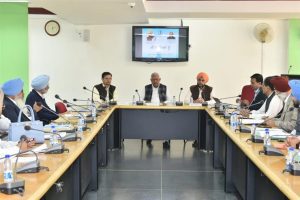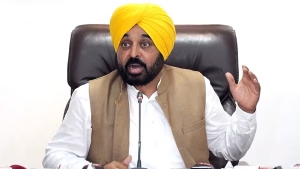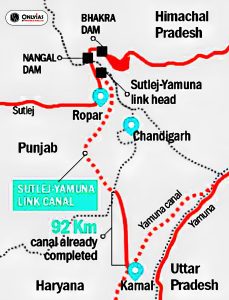Punjab – In a decisive move amid the escalating Punjab-Haryana Water Dispute, the Punjab Assembly passed a resolution on Monday firmly stating that the state will not provide “even a single additional drop of water” to neighboring Haryana beyond what is already being shared. Water Resources Minister Barinder Kumar Goyal tabled the resolution during a special session of the Assembly, highlighting the state’s growing concerns over water rights and distribution.

The Punjab-Haryana Water Dispute has intensified in recent weeks after Haryana requested 8,500 cusecs of water from the Bhakra-Nangal project on April 23, seeking 4,500 cusecs more than its current allocation. This demand has rekindled tensions between the two states over river water sharing, an issue that has remained contentious for decades.
Humanitarian Considerations Amid Political Tensions
Despite the firm stance taken in the resolution, the Punjab government has clarified that it will continue to provide 4,000 cusecs of water to Haryana for drinking purposes on humanitarian grounds. This aspect of the Punjab-Haryana Water Dispute demonstrates the complex balancing act between political positions and humanitarian considerations.
“Punjab showed a big heart and gave 4,000 cusecs of water to Haryana because our gurus have taught us that giving water to any thirsty person is a great virtue,” Minister Goyal stated during the Assembly session. He further explained that while Haryana’s population of approximately 3 crore requires only about 1,700 cusecs of water for drinking and other human needs, Punjab cannot accommodate the sudden increased demand of 8,500 cusecs.
The Punjab-Haryana Water Dispute highlights the increasing scarcity of water resources in the region, with both states feeling the pressure of diminishing water levels in their shared rivers.
Criticisms of BBMB and Centre’s Involvement
The Punjab Assembly resolution also strongly condemned what it described as the “illegal and unconstitutional” convening of the Bhakra Beas Management Board (BBMB) meeting by the BJP. This aspect of the Punjab-Haryana Water Dispute reveals the political dimensions of water governance in the region.
“At present, BBMB has become a mere puppet of the BJP government at the Centre. In BBMB meetings, Punjab is not heard, nor are its rights taken care of,” Goyal asserted, adding that the board should be reorganized to protect Punjab’s interests. The resolution pointed out procedural violations, stating that the BBMB does not follow the required notice period for meetings and sometimes convenes “illegal meetings at night.”
Also Read: Breaking | Punjab Water Dispute Explodes as State Unites Against Haryana
This criticism forms a significant part of the Punjab-Haryana Water Dispute narrative, as Punjab accuses central institutions of favoring Haryana in water allocation decisions.
Constitutional Challenges to Dam Safety Act
The Punjab Assembly resolution took aim at the Dam Safety Act of 2021, describing it as “an attack on the rights of Punjab.” The resolution claimed that this legislation enables the central government to directly control rivers and dams within states, even when a dam is entirely within state boundaries.

“This is against India’s federal structure and directly undermines the sovereign right of states like Punjab over their water,” the resolution stated, demanding that the central government repeal the Dam Safety Act immediately. This constitutional challenge adds another layer to the Punjab-Haryana Water Dispute, elevating it from a regional issue to one that questions the federal arrangement of natural resource governance.
The Punjab government’s rejection of the Dam Safety Act represents a significant political stance in the ongoing Punjab-Haryana Water Dispute, as it directly challenges the central government’s authority over state water resources.
Historical Context of Water Sharing Agreements


Minister Goyal raised fundamental questions about the basis of water sharing in the region, noting that the Sutlej, Ravi, and Beas rivers flow only through Punjab. “Then, on what basis are their waters being given to other states?” he questioned, highlighting the geographical aspect of the Punjab-Haryana Water Dispute.
The minister also challenged the 1981 water-sharing agreement between the states, pointing out that the amount of water specified in the agreement and subsequently distributed among states was much higher than what is actually available in these rivers today. “Because of this, a new agreement should be made for sharing the water of these rivers,” Goyal suggested, calling for a renegotiation of terms to reflect current water realities.
This historical context is crucial to understanding the Punjab-Haryana Water Dispute, as it frames the current conflict within a decades-long disagreement over water rights and allocation.
Punjab’s Improved Canal Water Distribution
The resolution highlighted the significant progress made by the Bhagwant Mann government in expanding canal water distribution across Punjab. According to Minister Goyal, until 2021, only 22 percent of Punjab’s fields received canal water, but today that figure has risen to approximately 60 percent.
“A network of canals and water courses has been built on a very large scale,” Goyal explained, adding that this expansion has made “every single drop of Punjab’s water very precious.” This advancement in irrigation infrastructure plays a key role in the Punjab-Haryana Water Dispute, as Punjab now claims it has no surplus water to share with other states.
The improvement in canal water distribution represents Punjab’s efforts to maximize the utilization of its water resources, further complicating the Punjab-Haryana Water Dispute by reducing the likelihood of additional water sharing.
Political Allegations and BJP’s Role
The Punjab Assembly resolution directly accused the BJP of attempting to “take away Punjab’s rights through its government in Haryana, the central government, and BBMB.” Minister Goyal claimed that by calling BBMB meetings in an “unconstitutional and illegal manner,” the BJP was trying to forcefully divert Punjab’s rightful water to Haryana.

“Haryana has used all its share of water till March 31. Now the BJP wants to give Punjab’s water to Haryana,” Goyal stated, framing the Punjab-Haryana Water Dispute in explicitly political terms. This accusation reflects the political tensions that often underlie resource disputes between states, especially when different political parties govern neighboring states.
The political dimension of the Punjab-Haryana Water Dispute demonstrates how water resources can become bargaining chips in broader political conflicts between states and the central government.
Legal Framework and BBMB’s Powers
The resolution emphasized that the 1981 treaty clearly outlines the quantity of water allocated to each state and asserted that “BBMB has no power to change it.” According to Punjab’s stance in the Punjab-Haryana Water Dispute, if BBMB attempts to reallocate one state’s share of water to another state through a meeting, such decisions would be “illegal and unconstitutional.”
This legal challenge to BBMB’s authority represents a critical component of the Punjab-Haryana Water Dispute, as it questions the decision-making power of a central institution in matters of interstate water sharing.
Closing Remarks: Implications for Interstate Relations
The Punjab-Haryana Water Dispute has significant implications for interstate relations and water governance in India. The firm stance taken by the Punjab Assembly through this resolution signals a hardening of positions that could complicate efforts to find a negotiated solution to the water-sharing issue.
As water scarcity becomes an increasingly pressing concern across India, the Punjab-Haryana Water Dispute serves as a case study in how competing claims over limited water resources can escalate into political and constitutional challenges. The resolution passed by the Punjab Assembly demonstrates how water disputes can quickly evolve from technical disagreements about allocation to fundamental questions about state rights and federal governance.
The outcome of this Punjab-Haryana Water Dispute will likely have far-reaching consequences for how interstate water conflicts are managed in India, potentially setting precedents for similar disputes in other water-stressed regions of the country.

